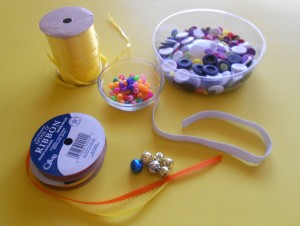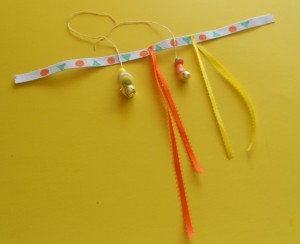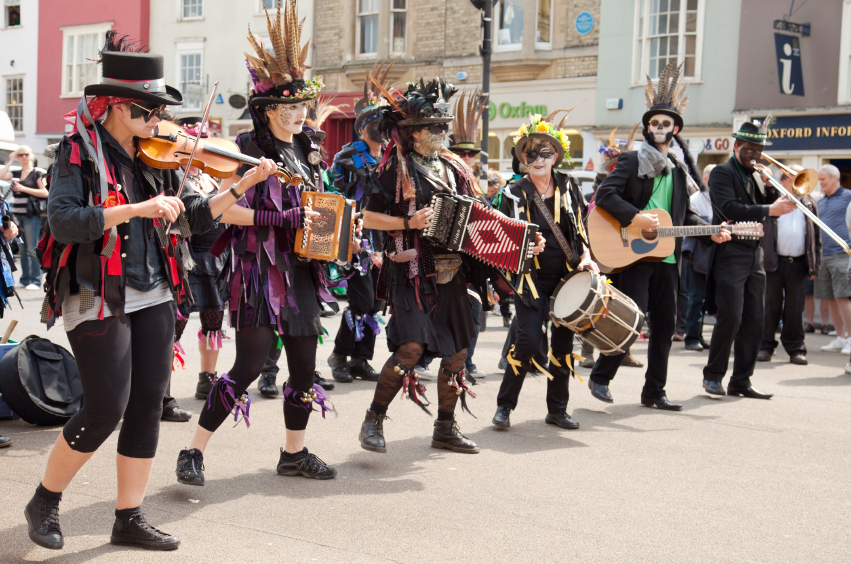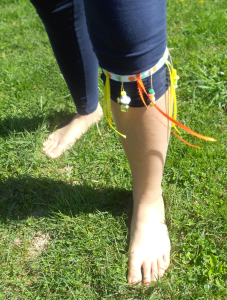Around May Day, dancers in parts of England are getting ready to welcome the Spring by morris dancing. They dress in colorful costumes and the bright and happy morris dance music is punctuated by the jingling and jangling of special bells worn on the legs.
Since young children love to move and dance, making an easy version of this traditional “knee-pad” instrument can be a fun way to welcome a new season, to exercise and to explore world cultures.
 Here are the supplies you need for a simple, homemade version of morris dancing bells.
Here are the supplies you need for a simple, homemade version of morris dancing bells.
Supplies
Two short lengths of elastic of any width (about 10 – 14” long)
A handful of jingle bells
Any number of extra buttons, beads or similar jangles.
Assorted ribbons, yarns and embroidery thread
Needle and Thread
Start by cutting two pieces of elastic and making sure they can comfortably stretch around a child’s leg and sit just under the knee. Leave a bit of extra length for the elastic to overlap. This will be where you will sew or pin it in place.
 Place your elastic “laid out straight” onto your work area. Since most elastic is white, you can use markers to color and decorate it before you add ribbons and bangles.
Place your elastic “laid out straight” onto your work area. Since most elastic is white, you can use markers to color and decorate it before you add ribbons and bangles.
Create the hanging jingles by threading a jingle bell on a small ribbon or piece or embroidery thread. Tie it onto the end and then add on any other buttons, beads or jangles that you like. When you’ve reached the desired length, tie it in place onto your elastic. Add as many of these as you like.
Add some ribbons or yarn to the morris bells. Sew or tie them into place. They may not add to the sound of your instrument, but they will move as you dance and add to the overall beauty of what you’ve created.
Last, sew or safety pin your morris bells to the right size for fitting around the leg of your child.
You can use this craft to explore the music of morris dancing or the general music of the British Isles. Or you can dance to any of your favorite songs. If you get a chance to see actual morris dancers, you’ll notice that both boys and girls participate in this dance tradition.
Although there are many different traditions of morris dancing, some also involve waving handkerchiefs, dressing up in wild clothes or having a parade – all fun activities to do to welcome the Spring.










 Singing with your children is one of the simple pleasures of the holiday season. It’s a great time to relive memories from your childhood and also to make new ones for your family! Have you ever thought of making your own, custom-tailored Christmas song? If you have creative kids and a sense of humor, you can easily make your own version of the classic holiday song – the Twelve Days of Christmas.
Singing with your children is one of the simple pleasures of the holiday season. It’s a great time to relive memories from your childhood and also to make new ones for your family! Have you ever thought of making your own, custom-tailored Christmas song? If you have creative kids and a sense of humor, you can easily make your own version of the classic holiday song – the Twelve Days of Christmas. Almost every parent has had the experience of giving their child a special present and finding that they were more excited about playing with the box. So, why fight it? With the holidays bringing so many different size and shape packages to your doorstep, it’s a great time to have a little musical fun by creating instruments called rattle boxes. If you add textured fabric or paper as you decorate them, it becomes a musical and sensory experience as well!
Almost every parent has had the experience of giving their child a special present and finding that they were more excited about playing with the box. So, why fight it? With the holidays bringing so many different size and shape packages to your doorstep, it’s a great time to have a little musical fun by creating instruments called rattle boxes. If you add textured fabric or paper as you decorate them, it becomes a musical and sensory experience as well! Make Your Box Rattle!
Make Your Box Rattle!  Shake, Rattle and Roll Away!
Shake, Rattle and Roll Away! Have you ever seen Spanish castanets? Traditional ones are beautifully crafted or carved from wood and often painted with themes like the Spanish countryside or elegant dancers. Playing the castanets is a fun way of allowing a child to develop a sense of rhythm, fine motor skills and also a great way to explore the music and culture of Spain.
Have you ever seen Spanish castanets? Traditional ones are beautifully crafted or carved from wood and often painted with themes like the Spanish countryside or elegant dancers. Playing the castanets is a fun way of allowing a child to develop a sense of rhythm, fine motor skills and also a great way to explore the music and culture of Spain.
 This craft is so easy that even an adult can do it! Feel free to learn and play along with your child. Simply put the button castanets between your thumb and first finger and click away. Play fast, slow, or tap back and forth between the left hand and right hand. Click or clack along to a favorite song or rhyme or put on a recording of music that you love. See if you can match the beat you hear or create a new one that works with the song.
This craft is so easy that even an adult can do it! Feel free to learn and play along with your child. Simply put the button castanets between your thumb and first finger and click away. Play fast, slow, or tap back and forth between the left hand and right hand. Click or clack along to a favorite song or rhyme or put on a recording of music that you love. See if you can match the beat you hear or create a new one that works with the song.
 This post was written as a contribution to the Living Life Special Blog Carnival. The participating bloggers are sharing their experiences in parenting or teaching children with special needs. Also included are posts on how to educate others about special needs.
This post was written as a contribution to the Living Life Special Blog Carnival. The participating bloggers are sharing their experiences in parenting or teaching children with special needs. Also included are posts on how to educate others about special needs. A DRUM THAT SOUNDS LIKE THE OCEAN
A DRUM THAT SOUNDS LIKE THE OCEAN 

 Travel to the rainforests by creating your own unique rainstick. Add designs from South America, Australia or the American Southwest. You can also decoupage or quilt one and it will last for years! To make a homemade rainstick, you’ll need sturdy mailing tube (with end caps) a bit of floral wire, jewelry wire, pipecleaners and some different ingredients that will help create the sound of the rain as they trickle back and forth throughout the tube.
Travel to the rainforests by creating your own unique rainstick. Add designs from South America, Australia or the American Southwest. You can also decoupage or quilt one and it will last for years! To make a homemade rainstick, you’ll need sturdy mailing tube (with end caps) a bit of floral wire, jewelry wire, pipecleaners and some different ingredients that will help create the sound of the rain as they trickle back and forth throughout the tube. This week we wanted to share a guest post and a wonderfully simple musical craft and activity from Cari at Time For Play – Button Gloves!
This week we wanted to share a guest post and a wonderfully simple musical craft and activity from Cari at Time For Play – Button Gloves!

 A
A 